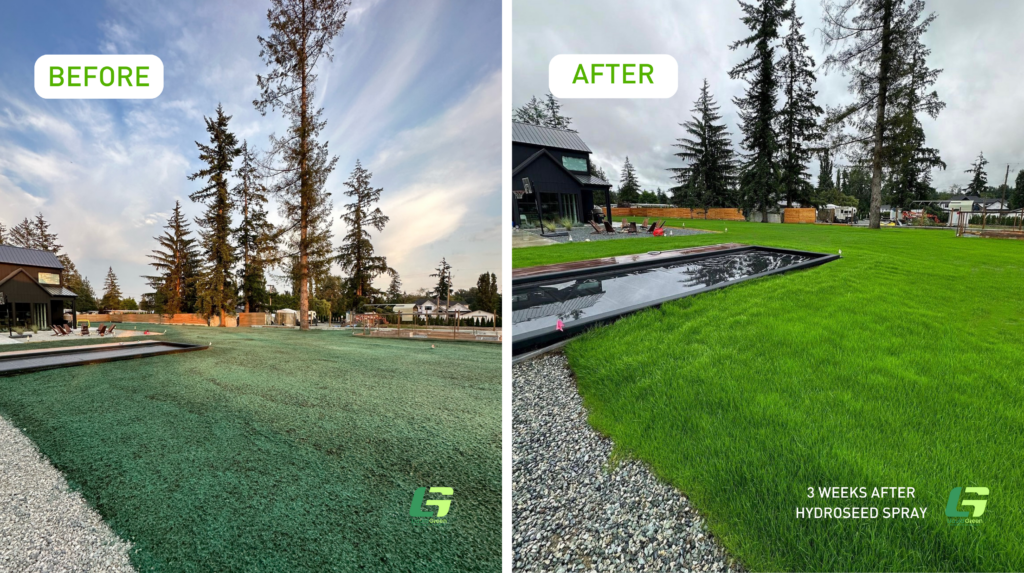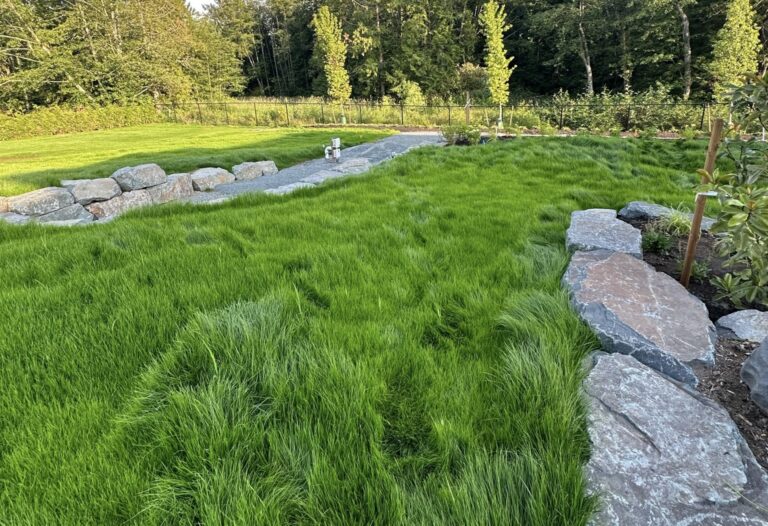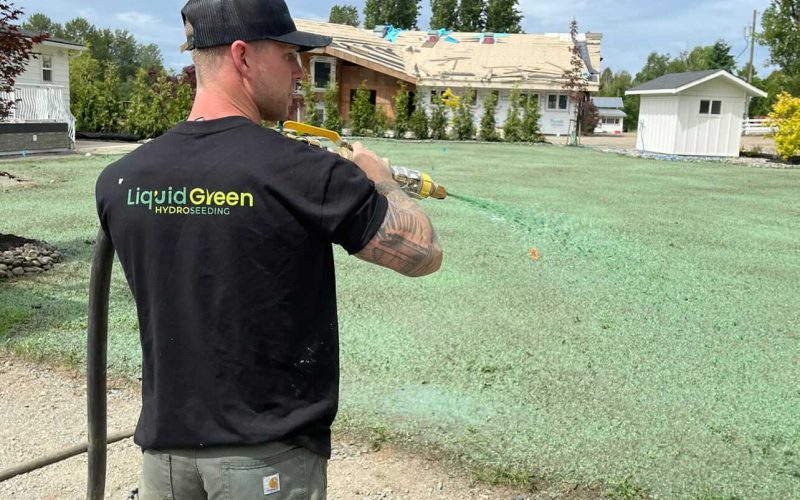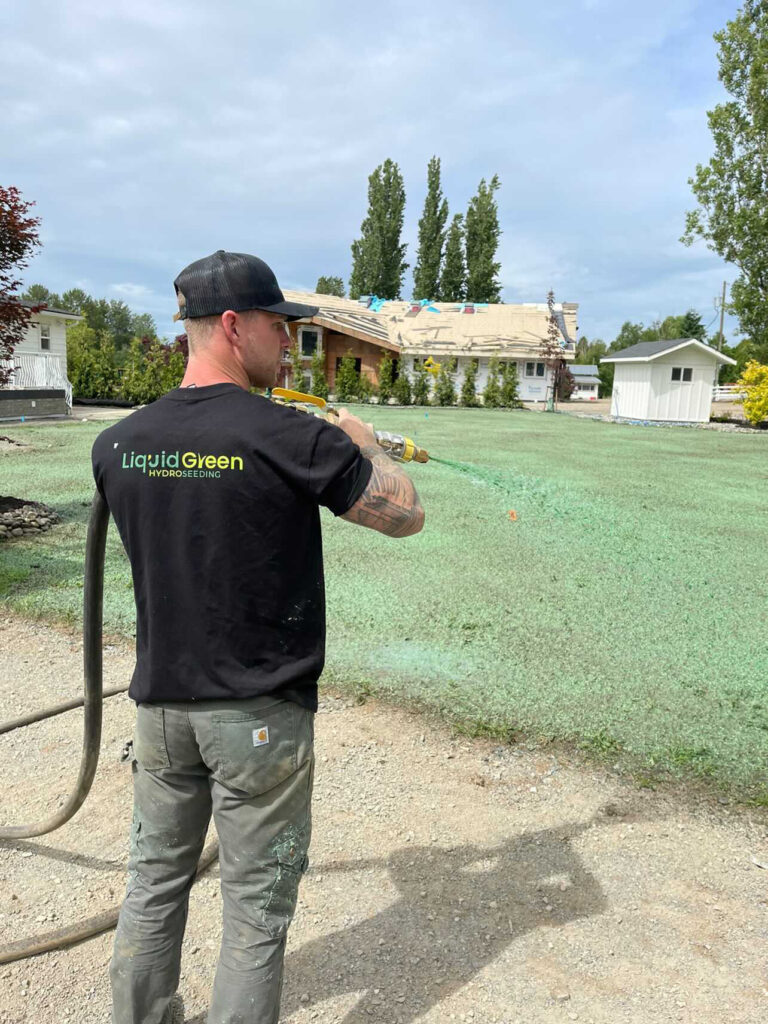What is Hydroseeding and How Does it Work?
What is Hydroseeding?
Hydroseeding is a seeding technique that involves spraying a specially formulated mixture onto the soil. The mixture comprises seeds, mulch, fertiliser, tackifier, and water. This process allows for even seed distribution and creates an ideal environment for seed germination and plant growth. Additionally, hydroseeding is an eco-friendly option as it minimises soil erosion and utilises organic materials. Hydroseeding excels in establishing lush lawns for residential properties, parks, and sports fields. In commercial settings, hydroseeding proves invaluable for erosion and sediment control on construction sites. For expansive areas like golf courses and highways, hydroseeding efficiently covers large plots, ensuring uniform and rapid growth. In reclamation projects, it aids in restoring damaged landscapes, such as landfills or wetlands. Hydroseeding is also ideal for pastures, providing high-feed value and supporting animal comfort.
How Does Hydroseeding Work?
Hydroseeding involves spraying a blend of grass seed, mulch, fertiliser, and water onto prepared soil, creating an ideal environment for seed germination. This method promotes robust growth, allowing the grass seedlings to develop into a lush and vibrant lawn. The combined elements in the hydroseed grass mixture work synergistically, fostering a conducive setting for healthy root establishment and ensuring a dense, uniform lawn coverage. The process is efficient, providing a rapid and effective solution for achieving a thriving green landscape.
Components of the Hydroseed Mixture
Hydroseed mix comprises essential components for successful germination and growth.
Grass seed selection, tailored to project specifics like climate and soil type, ensures optimal outcomes, be it ornamental, sports, or erosion control purposes.
Mulch, crafted from wood fibres, paper, or biodegradable materials, acts as a protective shield, retaining moisture and providing a stable environment for seed development.
Fertiliser kickstarts growth, offering crucial nutrients for young plants.
Water, a fundamental element, hydrates seeds, dissolves fertiliser, and forms a slurry when combined with other components, essential for the germination process.
This synergistic blend creates an ideal environment, fostering robust plant development in hydroseeding applications across diverse projects.
Types of Seeds Used
Diverse hydroseed grass varieties, including bluegrass, fescue, rye, Bermuda, Bahia, centipede, and native grasses, exhibit varying tolerances to factors like climate, soil type, and maintenance needs. Each variety contributes distinct characteristics to hydroseeding projects, ensuring adaptability and resilience.
- Bluegrass: Known for lush, fine texture and cold tolerance.
- Fescue: Thrives in diverse climates, offering versatility.
- Rye grasses: Rapid germination and establishment in cool seasons.
- Bermuda: Ideal for warm climates, known for drought resistance.
- Bahia: Well-suited for sunny, warmer regions with good drought tolerance.
- Centipede: Thrives in acidic soils, low maintenance, and moderate shade tolerance.
For a detailed understanding of grass seed growth timelines, check out how long for grass seed to grow.
Machines & Equipment
Liquid Green employs state-of-the-art machinery for hydroseeding. The hydroseeder is a tank-like apparatus equipped with a powerful pump, expertly mixing grass seed, mulch, fertiliser, and water into a slurry. This advanced machine ensures an even application through a precision spraying mechanism. Additionally, we may utilise a mulch blower to supplement hydroseeding, applying additional mulch for enhanced erosion control and seed protection. Our specialised equipment exemplifies efficiency, precision, and innovation, ensuring optimal results for lawn hydroseeding and commercial hydroseeding.
The Hydroseeding Process
1. Site Assessment and Soil Preparation
Our experts evaluate the site conditions, soil quality, and terrain characteristics to customise the hydroseeding approach.
To prepare for hydroseeding, customers must remove debris, rocks, and existing vegetation to establish a clean canvas for the new lawn. Conducting a soil test is essential to gauge nutrient levels and pH. This meticulous site preparation is crucial, ensuring optimal seed-to-soil contact and promoting uniform growth for a successful hydroseeding outcome.
2. Customised Seed and Mixture Selection
Based on your specific requirements, we carefully select the appropriate seeds, mulch, and additives to ensure optimal hydroseeding results.
3. Application
Our experienced technicians utilise specialised hydroseeding equipment to uniformly apply the mixture, ensuring comprehensive coverage.
The hydroseeding process starts with the slurry, comprising grass seed, mulch, fertiliser, and water, being loaded into the machine's tank. A powerful pump propels the slurry through a lengthy hose, precisely distributing it across the prepared area through a specially designed nozzle. The spraying process coats the soil with a green layer, fostering seed germination and the initial stages of growth, ensuring an even and effective hydroseeded area.
3. Post-Hydroseeding Care
We provide guidance on proper watering techniques and maintenance practices to facilitate successful seed germination and establishment.
Adequate and consistent watering is imperative for the success of a hydroseeded lawn, particularly during the critical germination and establishment phases and when learning how to care for hydroseed.
Mowing: Once the grass reaches a recommended height, typically 3 to 4 inches, mowing can commence. Regular mowing encourages healthy growth, strengthens roots, and promotes a lush appearance.
Fertilising: Applying a balanced fertiliser at appropriate intervals provides essential nutrients, promoting vigorous growth, colour, and overall lawn health.
Weed control: Implementing effective weed control measures is crucial and hydroseeding will help your lawn remain weedless. This is just one of the hydroseeding pros. Regular inspections and targeted herbicide applications can prevent weed competition and maintain the integrity of the hydroseeded area. Following these practices ensures the long-term health and vibrancy of the hydroseeded lawn.
Before and After Hydroseeding
Depending on environmental factors, you can expect visible results within a few weeks, and a healthy, vibrant lawn within a few months.
Liquid Green takes pride in our customers' results. These images are some before vs after photos of Liquid Green clients hydroseeding results with proper care.

What's the Best Time to Hydroseed My Lawn?
In the spring, late summer and early fall, hydroseeding benefits from warm soil, diminished weed competition, lower heat stress, and milder weather conditions—a favourable combination for successful grass establishment.
Applications of Hydroseeding
- Residential landscaping and lawns: Lawn hydroseeding is ideal for homeowners seeking a lush and beautiful lawn that enhances the overall aesthetics of their property.
- Commercial and industrial sites: Hydroseeding is a practical choice for establishing vegetation in commercial and industrial areas, providing a green and welcoming environment.
- Highway and roadside vegetation restoration: Hydroseeding is effective in restoring vegetation along highways and roadways, reducing erosion and enhancing the visual appeal of the surroundings.
- Erosion control on slopes and embankments: Hydroseeding plays a crucial role in stabilising slopes and embankments, preventing soil erosion and promoting the growth of vegetation to reinforce the stability of these areas.
- Land reclamation projects: Hydroseeding is widely used in land reclamation initiatives, transforming barren or disturbed land into thriving ecosystems, promoting biodiversity, and restoring natural habitats.
Hydroseeding grass is also highly effective for sports fields such as soccer fields, baseball diamonds, and golf courses. Its application ensures uniform growth, creating resilient and visually appealing playing surfaces. To learn more about the benefits of hydroseeding lawns and over existing lawns, visit hydroseeding over lawn.
Hydroseeding vs Other Seeding Methods
Traditional Hand Seeding
Hydroseeding surpasses traditional hand seeding methods by providing more uniform seed distribution, faster germination, and better erosion control.
Sod Installation
While sod installation offers immediate results, hydroseeding is a more cost-effective option for larger areas, providing comparable root establishment and long-term lawn health.
Straw Mulching
Hydroseeding grass offers superior erosion control and soil stabilisation compared to straw mulching, ensuring better coverage and protection against wind erosion.
Blanket Erosion Control
Hydroseeding provides better seed-to-soil contact and higher germination rates compared to blanket erosion control methods, resulting in more effective erosion control and vegetation establishment.
Choosing hydroseeding for accelerated lawn growth is preferred over traditional methods. Let's take a look at the unique pros and cons of hydroseeding below:
Advantages of Hydroseeding
There are several benefits of hydroseeding for commercial and residential areas, making it a preferred choice for various projects.
- Accelerated Seed Germination: Hydroseeding facilitates faster and more efficient seed germination, ensuring quicker establishment of the lawn.
- Uniform Growth: It significantly reduces the risk of patchy or uneven growth, providing a consistently lush and vibrant lawn.
- Cost-Effective for Large Projects: Hydroseeding is a cost-effective solution, particularly for larger areas, offering savings on materials, labour, and overall project expenses.
- Environmentally Friendly: As an eco-friendly option, hydroseeding minimises the need for excessive chemical treatments, promoting sustainable and environmentally conscious landscaping practices.
These benefits collectively make hydroseeding grass a versatile and eco-conscious approach for achieving vibrant and healthy landscapes.
Disadvantages of Hydroseeding
Depending on the scope of your project, there are a few considerations to be aware of when choosing to have your area hydroseeded.
- Specialised Equipment: Hydroseeding demands specialised machinery and equipment for effective application.
- Maintenance Importance: In order to get great hydroseeding results, post-hydroseeding maintenance is crucial; neglect can lead to subpar outcomes.
- DIY Challenges: Hydroseeding is less DIY-friendly compared to traditional seeding methods, requiring professional expertise.
- Weather Dependency: The success of hydroseeding is influenced by weather conditions, emphasising the need for strategic timing and planning.
How Much Does Hydroseeding Cost: Factors to Consider
Understanding hydroseeding costs, ranging from $0.13 to $0.20 per square foot, involves considering multiple factors. When reviewing these factors, it's important to reflect on your lawn or commercial goals and know that the cost can vary depending on what the desired outcome is. Liquid Green will work closely with you to help achieve your hydroseed grass goals while staying within the desired budget. No job is too big or too small for Liquid Green and our team will ensure all information and costs are communicated before we start our process, so there are no hidden fees or large, unexpected bills.
- Area Size:The size of the hydroseeding project significantly impacts the overall cost, with larger areas incurring higher expenses.
- Cost of Seed: Different seed selections come with varied price points, influencing the overall budget.
- Preparation Work: The extent and complexity of site preparation contribute to the total cost.
- Additional Services: If additional services like erosion control or fertilisation are needed, they will influence the overall expenses.
- Accessibility of the Work Area: The ease or difficulty of accessing the work area can affect pricing.
- Customization to the Mixture: Tailoring the hydroseed mixture to specific project requirements may incur additional costs.
For an accurate cost estimate tailored to your unique hydroseeding project, contact us. Visit Hydroseeding Cost to gain more insights into hydroseeding expenses.
Hiring a Hydroseeding Service vs DIY Hydroseeding
DIY hydroseed grass seed can be a suitable option for smaller areas, allowing homeowners to control costs and participate in the process. However, it demands substantial time, effort, and a learning curve and risk of inexperience which will affect the project success and will waste money and time. Hydroseeding pros include the expertise and efficiency of professional hydroseeding services for large and small jobs. Hiring professional hydroseeding services ensures the correct application of the hydroseed mixture, precise equipment use, and a higher likelihood of successful germination and establishment.
Transform Your Landscape with Liquid Green
Hydroseeding is a game-changer in the world of landscaping and erosion control. Its benefits, including faster germination, superior erosion control, cost-effectiveness, and versatility, make it an excellent choice for transforming landscapes of all types. Contact our experienced team today to explore how hydroseeding can enhance the beauty and sustainability of your outdoor spaces. Together, let’s create hydroseeding results that exceed your expectations and stand the test of time.



